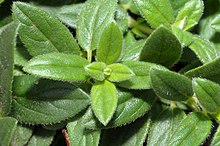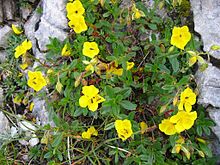Yellow sun rose
| Yellow sun rose | ||||||||||||
|---|---|---|---|---|---|---|---|---|---|---|---|---|

Yellow sun rose ( Helianthemum nummularium ) |
||||||||||||
| Systematics | ||||||||||||
|
||||||||||||
| Scientific name | ||||||||||||
| Helianthemum nummularium | ||||||||||||
| (L.) Mill. |
The yellow sun rose ( Helianthemum nummularium ), also known as common sun rose , common sun rose , sun rose and midsummer flower, is a species of plant from the genus sun rose ( Helianthemum ) within the rockrose family (Cistaceae). It belongs to the light indicators ( pointer plants ).
description
Vegetative characteristics
The yellow sun rose is an evergreen, perennial plant that lignifies at the base, grows as a deciduous, rarely to ascending subshrub and reaches heights of 10 to 30 centimeters. The opposite leaves are elliptical-ovate, entire and ciliate. The lanceolate stipules are longer than the petiole.
Generative characteristics
The flowering period extends from May to September. The mostly one-sided, racemose inflorescence has few flowers . The hermaphroditic flowers are 8 to 18 millimeters in diameter and are radially symmetrical and five-fold with a double flower envelope . The sepals are often reddish-streaked. The five petals are lemon to golden yellow. There are many stamens present. The loculicidal capsule fruit contains many seeds.
The chromosome number is 2n = 20 for the subspecies subsp. nummularium , subsp. glabrum , subsp. grandiflorum and subsp. obscurum .
ecology
The yellow sun rose has an ectotrophic mycorrhiza .
The yellow sun rose uses the warmer climate of the air layers close to the ground. The following characteristics are adaptations to dry locations (xeromorphoses): The coarse "leather leaves" have a rolled leaf edge and a glossy top side.
From an ecological point of view, these are solitary, homogamous "pollen disc flowers". The well over 100 stamens are secondary to reproduction (a tuft corresponds to an original stamen). The flowers are only open in the sun and only at temperatures above 20 degrees. The outer stamens react to contact with their base with immediate, slow spreading. This mechanism is used to dust pollen-seeking insects with pollen . This process is reversible. The petals have a strong UV reflection and are therefore easily visible to bees . The warmth and light-dependent opening and closing of the flowers can lead to spontaneous self-pollination . The flowers only “live” for one day. In the afternoon the petals fall off.
Fruit ripening takes place from July to November. In contrast to the flowers, the columnar dried capsule fruits turn away from the light, so they are negative phototropic. It is spread by wind and chance and, because of the stickiness of the seeds, it is also spread as sticky; the seeds are also spread as rainworm. It is about light germs .
Occurrence
Helianthemum nummularium is distributed in the Caucasus , Turkey and almost all of Europe except Iceland and Norway . As a location it prefers sunny dry slopes, heaths , forest edges and rocks.
Systematics
The first description was by Carl von Linné as Cistus nummularius . The new combination to Helianthemum nummularium (L.) Mill. Was made by Philip Miller .
The generic name Helianthemum is derived from the Greek words helios for sun and anthemon for flower. The specific epithet nummularium is derived from the Latin word nummulus , which means "small coin", because the golden yellow flowers glow like golden coins in the sunshine (the place where small coins are stored is also called "nummularium").
From Helianthemum nummularium there are at least eight subtypes:
- Helianthemum nummularium subsp. berteroanum (Bertol.) Breistr. : With occurrences from Italy to southeastern France.
- Bald common sun rose ( Helianthemum nummularium subsp. Glabrum (WDJ Koch) Wilczek ): Occurs from Central to Southern Europe. It is believed to be a species of the order Seslerietalia.
- Large-flowered common sun rose ( Helianthemum nummularium subsp. Grandiflorum (Scop.) Schinz & Thell. ): Occurring from Central to Southern Europe. It thrives in societies of the Seslerietalia order or the Erico-Pinion Association. This subspecies rises in the Allgäu Alps in Bavaria on the Kreuzeck up to an altitude of 2370 meters.
- Two-colored common sun rose ( Helianthemum nummularium (L.) Mill. Subsp. Nummularium ): It is widespread. It thrives in societies of the Xerobromion association, but also occurs in those of the Mesobromion, Violion or Geranion sanguinei associations.
- Oval-leaved common sun rose ( Helianthemum nummularium subsp. Obscurum (Celak.) Holub ): in central (e.g. Austria), south-east , south-west and north Europe . Is a character species of the order Brometalia, but also occurs in societies of the order Festucetalia valesiacae or the associations Violion, Geranion sanguinei or Erico-Pinion.
- Helianthemum nummularium subsp. pyrenaicum (Janchen) Schinz & Thell. : Is endemic to the Pyrenees .
- Helianthemum nummularium subsp. semiglabrum (Badaro) M. Proctor : Occurring from Italy to south-eastern France.
- Helianthemum nummularium subsp. tomentosum (Scop.) Schinz & Thell. : With occurrences from southern Europe to southern Switzerland.
Common names
The English-language common name Rock Rose (inadmissibly translated as " rock rose ") is due to Helianthemum nummularium's occurrence on rocky slopes of the low mountain range.
use
The yellow sun rose is used as a rock garden plant and used in Bach flower therapy .
There are also some varieties of Helianthemum nummularium (selection):
- 'Annabell' with double pink flowers
- 'The Bride', white single flowers
- 'Rose Glory' with dark pink flowers.
The "Ben" series in red and white tones goes back to the Scottish jute dealer John Nicoll from Dundee .
swell
literature
- Dankwart Seidl: Flowers. Munich 2001, ISBN 3-405-15766-8
- Dietmar Aichele: What is blooming there? The photo book. Wild flowering plants of Central Europe (= Kosmos natural classics ). 4th edition. Franckh-Kosmos, Stuttgart 2000, ISBN 3-440-08598-8 .
- Ruprecht Düll , Herfried Kutzelnigg : Pocket dictionary of plants in Germany and neighboring countries. The most common Central European species in portrait . 7th, corrected and enlarged edition. Quelle & Meyer, Wiebelsheim 2011, ISBN 978-3-494-01424-1 .
Individual evidence
- ↑ a b c d e Erich Oberdorfer : Plant-sociological excursion flora for Germany and neighboring areas. 8th edition. Verlag Eugen Ulmer, Stuttgart 2001, ISBN 3-8001-3131-5 . Page 668–669.
- ↑ a b c Helianthemum nummularium in the Germplasm Resources Information Network (GRIN), USDA , ARS , National Genetic Resources Program. National Germplasm Resources Laboratory, Beltsville, Maryland. Retrieved December 11, 2015.
- ↑ Erhard Dörr, Wolfgang Lippert : Flora of the Allgäu and its surroundings. Volume 2, IHW, Eching 2004, ISBN 3-930167-61-1 , p. 228.
Web links
- Liber Herbarum II - Helianthemum nummularium (accessed June 21, 2008)
- Yellow sun rose . In: BiolFlor, the database of biological-ecological characteristics of the flora of Germany.
- Helianthemum nummularium (L.) Mill. Sl, common sun rose. In: FloraWeb.de.
- Helianthemum nummularium subsp. nummularium (L.) Mill., common sun rose. In: FloraWeb.de.
- Helianthemum nummularium subsp. glabrum (WDJ Koch) Wilczek, Kahles Sonnenröschen. In: FloraWeb.de.
- Helianthemum nummularium subsp. grandiflorum (Scop.) Schinz & Thell., large-flowered sun rose. In: FloraWeb.de.
- Helianthemum nummularium subsp. obscurum (Celak.) Holub, dark sun rose. In: FloraWeb.de.
- Profile and distribution map for Bavaria . In: Botanical Information Hub of Bavaria .
- Helianthemum nummularium (L.) Mill. S. l. In: Info Flora , the national data and information center for Swiss flora .
- Helianthemum nummularium (L.) Mill. S. st. In: Info Flora , the national data and information center for Swiss flora . Retrieved December 11, 2015.
- Helianthemum nummularium subsp. glabrum (WDJ Koch) Wilczek In: Info Flora , the national data and information center for Swiss flora . Retrieved December 11, 2015.
- Helianthemum nummularium subsp. grandiflorum (Scop.) Schinz & Thell. In: Info Flora , the national data and information center for Swiss flora . Retrieved December 11, 2015.
- Helianthemum nummularium subsp. obscurum (Celak.) Holub In: Info Flora , the national data and information center for Swiss flora . Retrieved December 11, 2015.
- Helianthemum nummularium subsp. tomentosum (Scop.) Schinz & Thell. In: Info Flora , the national data and information center for Swiss flora . Retrieved December 11, 2015.
- Distribution in the northern hemisphere according to Eric Hultén
- Thomas Meyer: Data sheet with identification key and photos at Flora-de: Flora von Deutschland (old name of the website: Flowers in Swabia )
- Helianthemum nummularium at Plants For A Future
- Plantsphotos.de : Photos of fruit, seeds, flowers, etc.








